CHRYSLER CROSSFIRE 2008 1.G Owners Manual
Manufacturer: CHRYSLER, Model Year: 2008, Model line: CROSSFIRE, Model: CHRYSLER CROSSFIRE 2008 1.GPages: 358, PDF Size: 4.7 MB
Page 241 of 358
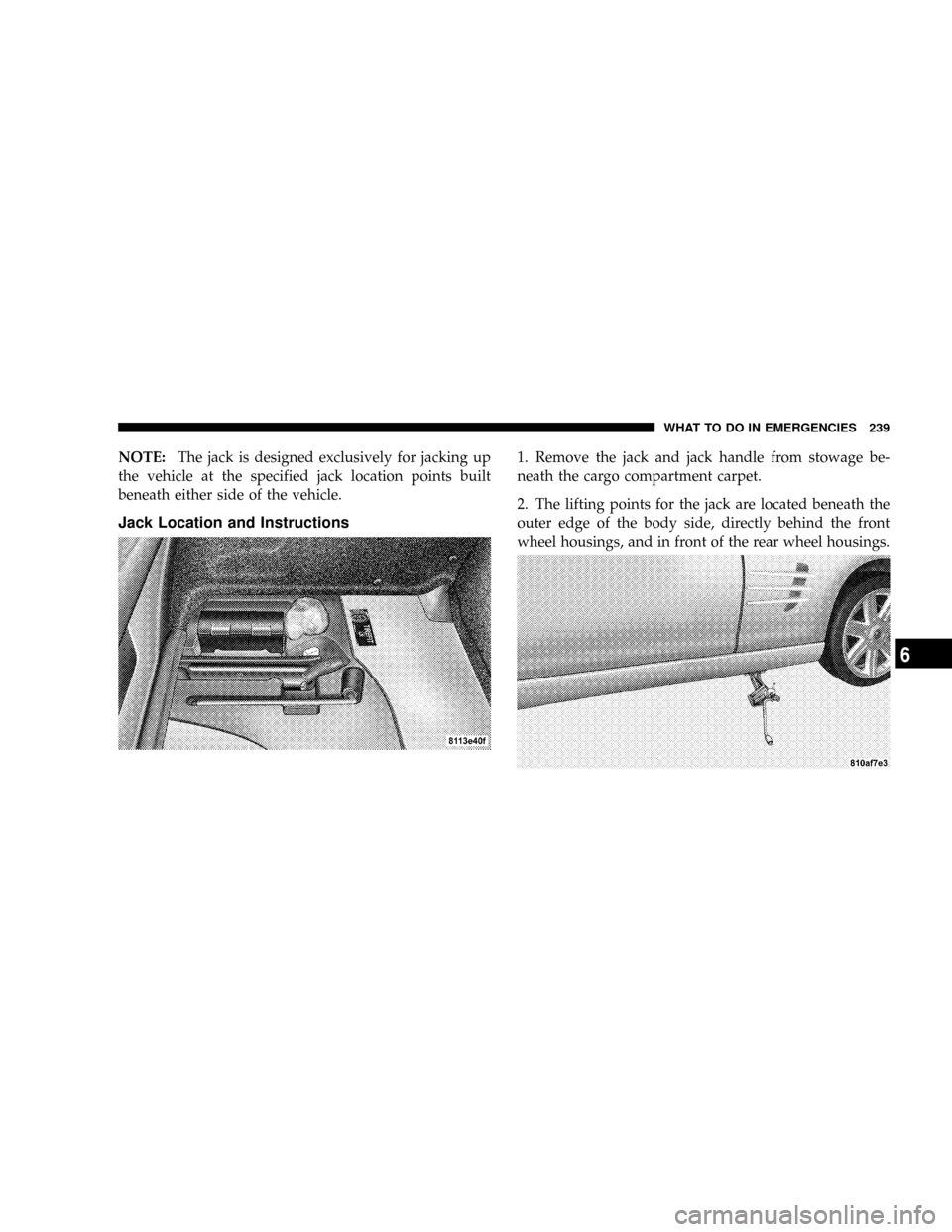
NOTE:The jack is designed exclusively for jacking up
the vehicle at the specified jack location points built
beneath either side of the vehicle.
Jack Location and Instructions
1. Remove the jack and jack handle from stowage be-
neath the cargo compartment carpet.
2. The lifting points for the jack are located beneath the
outer edge of the body side, directly behind the front
wheel housings, and in front of the rear wheel housings.
WHAT TO DO IN EMERGENCIES 239
6
Page 242 of 358
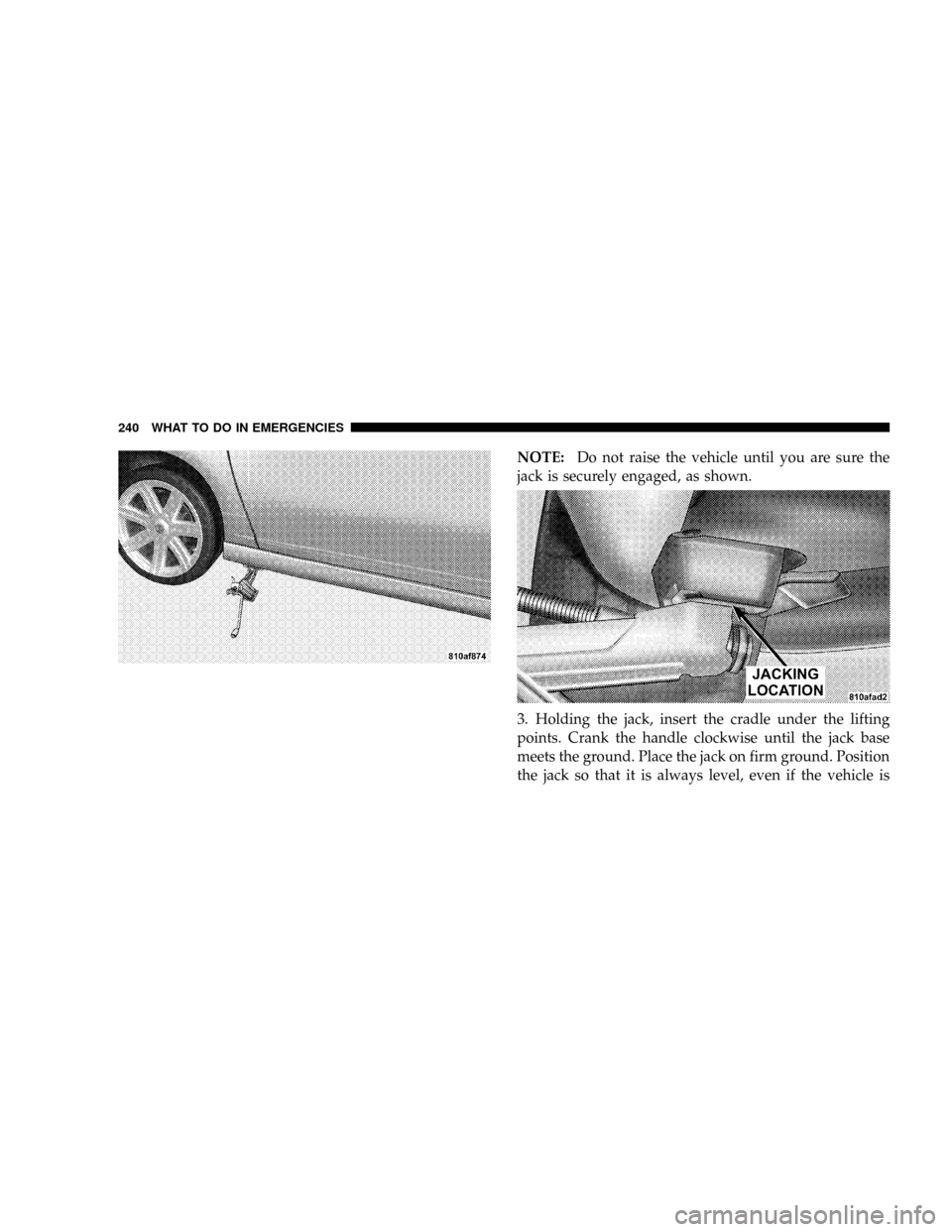
NOTE:Do not raise the vehicle until you are sure the
jack is securely engaged, as shown.
3. Holding the jack, insert the cradle under the lifting
points. Crank the handle clockwise until the jack base
meets the ground. Place the jack on firm ground. Position
the jack so that it is always level, even if the vehicle is
240 WHAT TO DO IN EMERGENCIES
Page 243 of 358
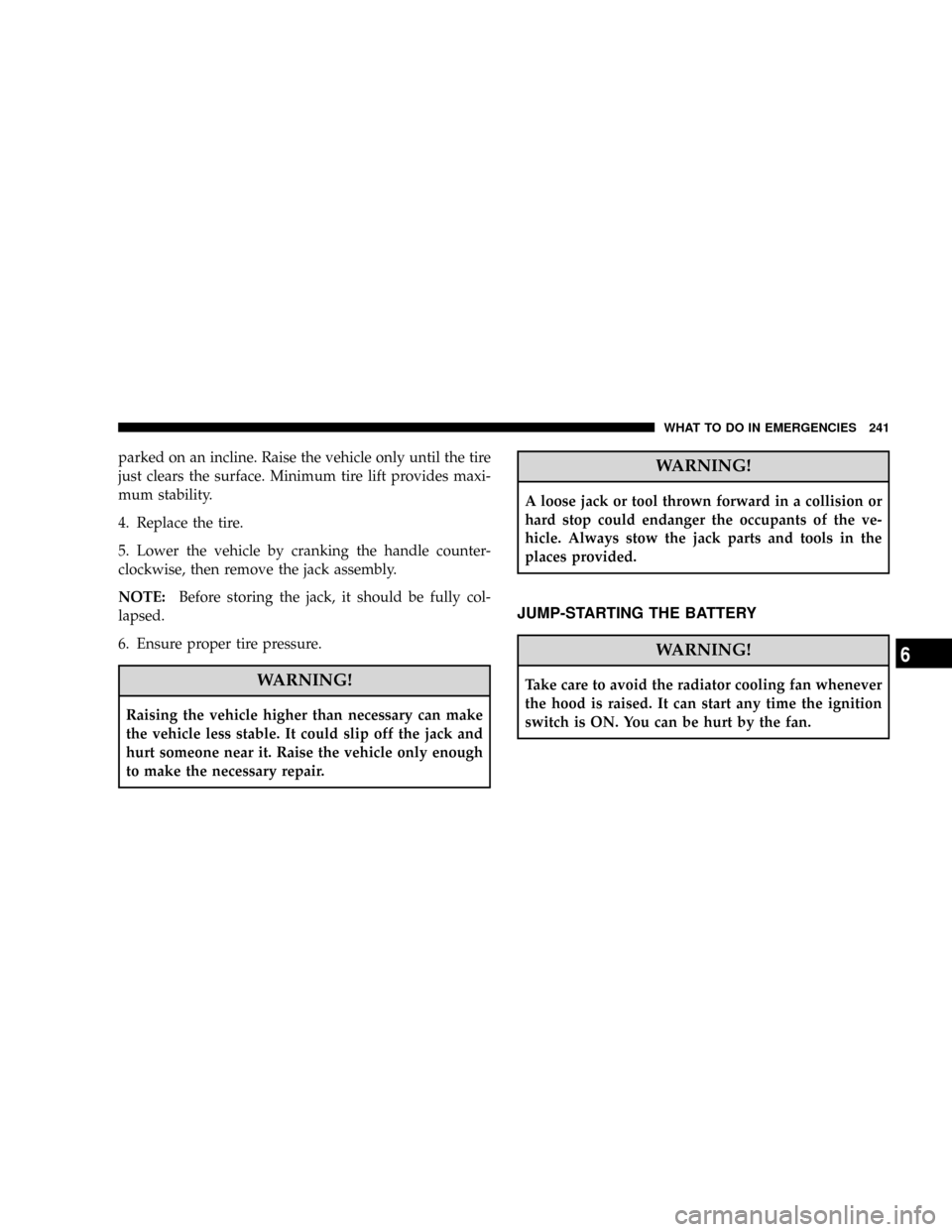
parked on an incline. Raise the vehicle only until the tire
just clears the surface. Minimum tire lift provides maxi-
mum stability.
4. Replace the tire.
5. Lower the vehicle by cranking the handle counter-
clockwise, then remove the jack assembly.
NOTE:Before storing the jack, it should be fully col-
lapsed.
6. Ensure proper tire pressure.
WARNING!
Raising the vehicle higher than necessary can make
the vehicle less stable. It could slip off the jack and
hurt someone near it. Raise the vehicle only enough
to make the necessary repair.
WARNING!
A loose jack or tool thrown forward in a collision or
hard stop could endanger the occupants of the ve-
hicle. Always stow the jack parts and tools in the
places provided.
JUMP-STARTING THE BATTERY
WARNING!
Take care to avoid the radiator cooling fan whenever
the hood is raised. It can start any time the ignition
switch is ON. You can be hurt by the fan.
WHAT TO DO IN EMERGENCIES 241
6
Page 244 of 358
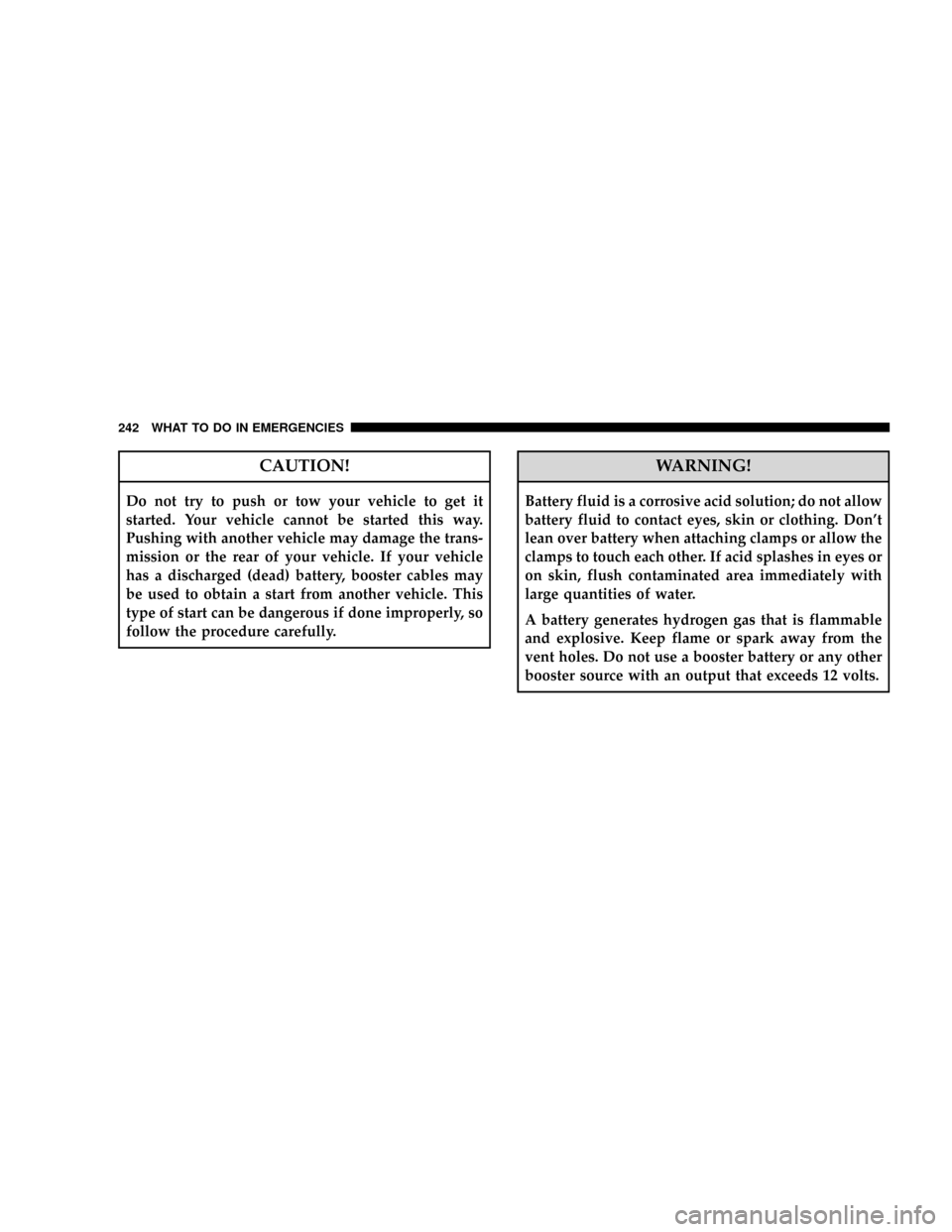
CAUTION!
Do not try to push or tow your vehicle to get it
started. Your vehicle cannot be started this way.
Pushing with another vehicle may damage the trans-
mission or the rear of your vehicle. If your vehicle
has a discharged (dead) battery, booster cables may
be used to obtain a start from another vehicle. This
type of start can be dangerous if done improperly, so
follow the procedure carefully.
WARNING!
Battery fluid is a corrosive acid solution; do not allow
battery fluid to contact eyes, skin or clothing. Don't
lean over battery when attaching clamps or allow the
clamps to touch each other. If acid splashes in eyes or
on skin, flush contaminated area immediately with
large quantities of water.
A battery generates hydrogen gas that is flammable
and explosive. Keep flame or spark away from the
vent holes. Do not use a booster battery or any other
booster source with an output that exceeds 12 volts.
242 WHAT TO DO IN EMERGENCIES
Page 245 of 358
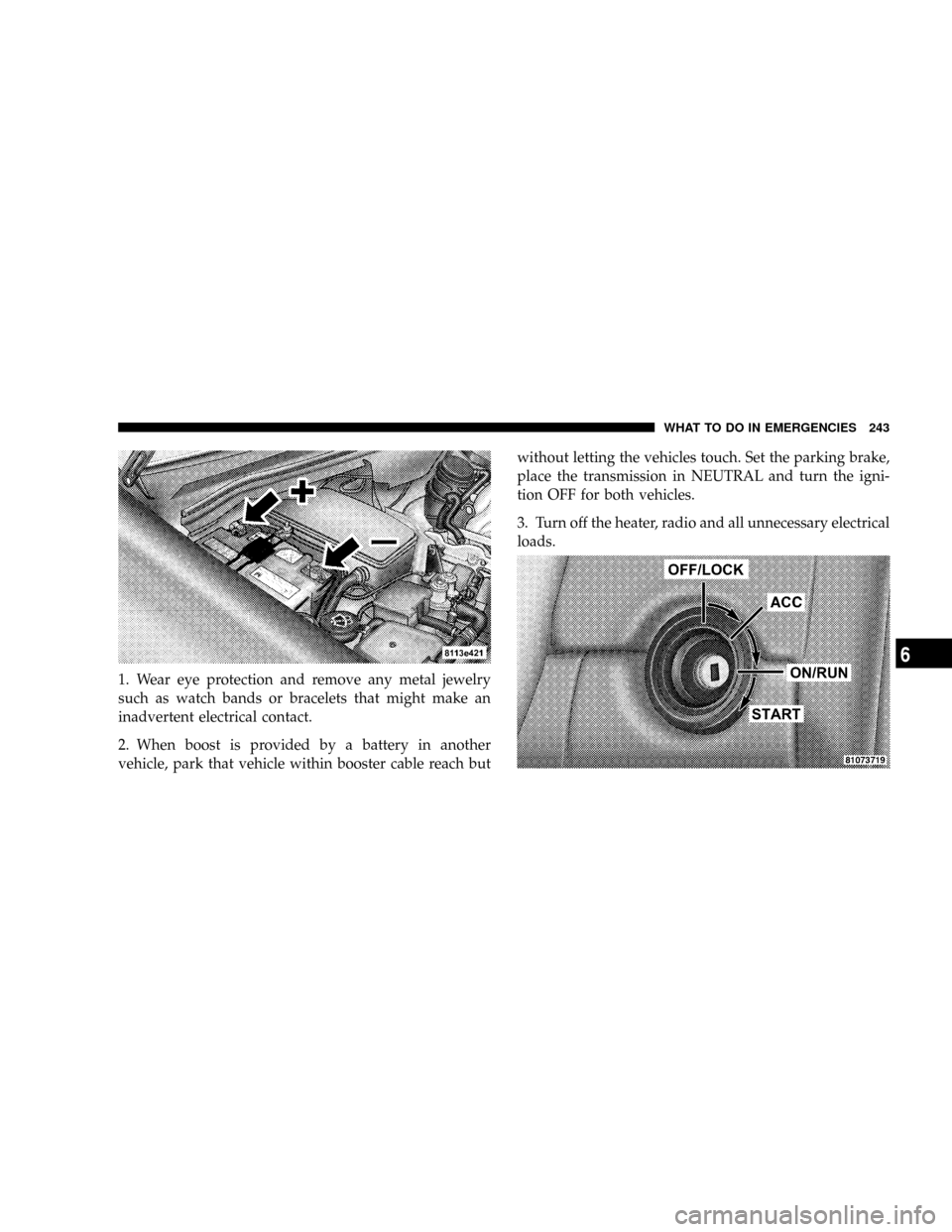
1. Wear eye protection and remove any metal jewelry
such as watch bands or bracelets that might make an
inadvertent electrical contact.
2. When boost is provided by a battery in another
vehicle, park that vehicle within booster cable reach butwithout letting the vehicles touch. Set the parking brake,
place the transmission in NEUTRAL and turn the igni-
tion OFF for both vehicles.
3. Turn off the heater, radio and all unnecessary electrical
loads.
WHAT TO DO IN EMERGENCIES 243
6
Page 246 of 358
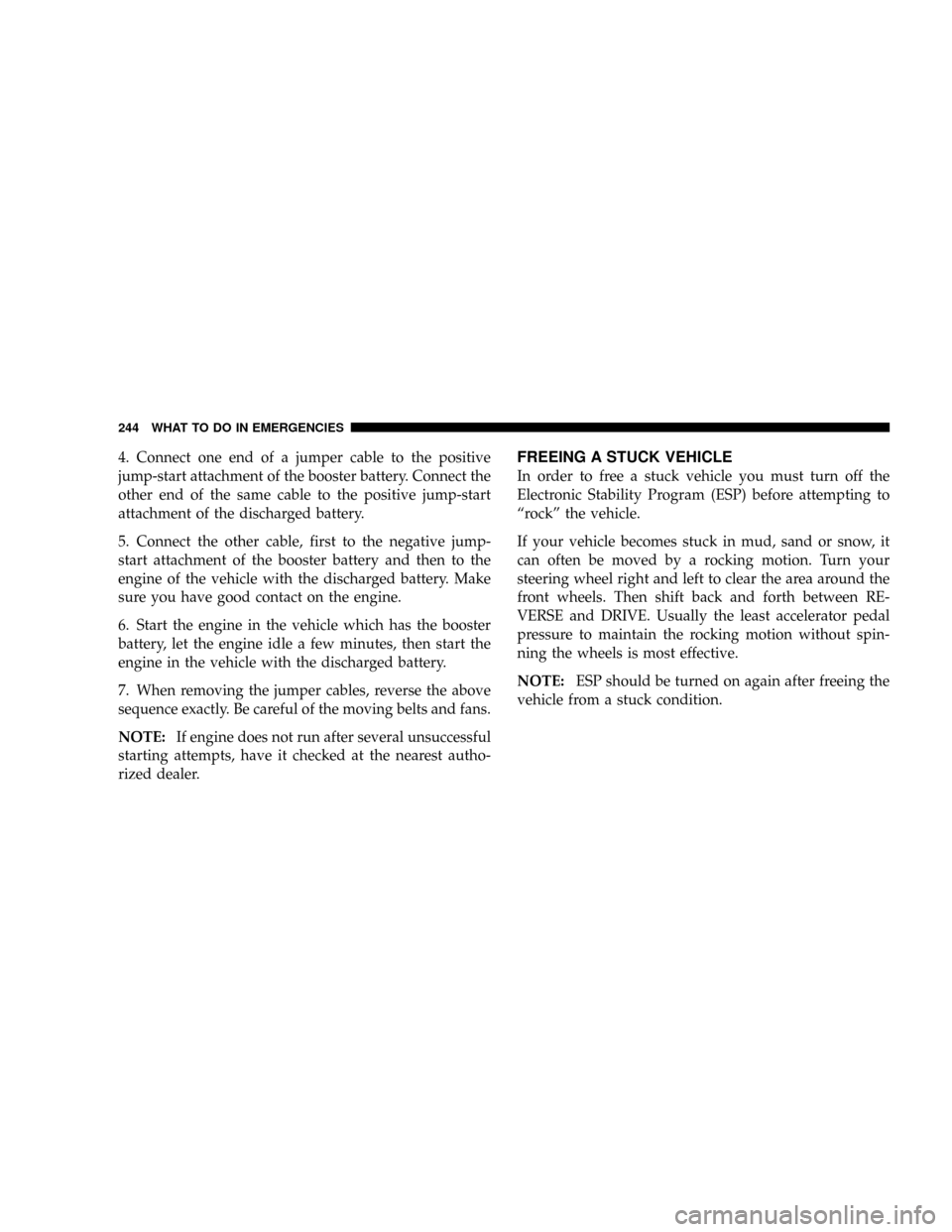
4. Connect one end of a jumper cable to the positive
jump-start attachment of the booster battery. Connect the
other end of the same cable to the positive jump-start
attachment of the discharged battery.
5. Connect the other cable, first to the negative jump-
start attachment of the booster battery and then to the
engine of the vehicle with the discharged battery. Make
sure you have good contact on the engine.
6. Start the engine in the vehicle which has the booster
battery, let the engine idle a few minutes, then start the
engine in the vehicle with the discharged battery.
7. When removing the jumper cables, reverse the above
sequence exactly. Be careful of the moving belts and fans.
NOTE:If engine does not run after several unsuccessful
starting attempts, have it checked at the nearest autho-
rized dealer.FREEING A STUCK VEHICLE
In order to free a stuck vehicle you must turn off the
Electronic Stability Program (ESP) before attempting to
ªrockº the vehicle.
If your vehicle becomes stuck in mud, sand or snow, it
can often be moved by a rocking motion. Turn your
steering wheel right and left to clear the area around the
front wheels. Then shift back and forth between RE-
VERSE and DRIVE. Usually the least accelerator pedal
pressure to maintain the rocking motion without spin-
ning the wheels is most effective.
NOTE:ESP should be turned on again after freeing the
vehicle from a stuck condition.
244 WHAT TO DO IN EMERGENCIES
Page 247 of 358
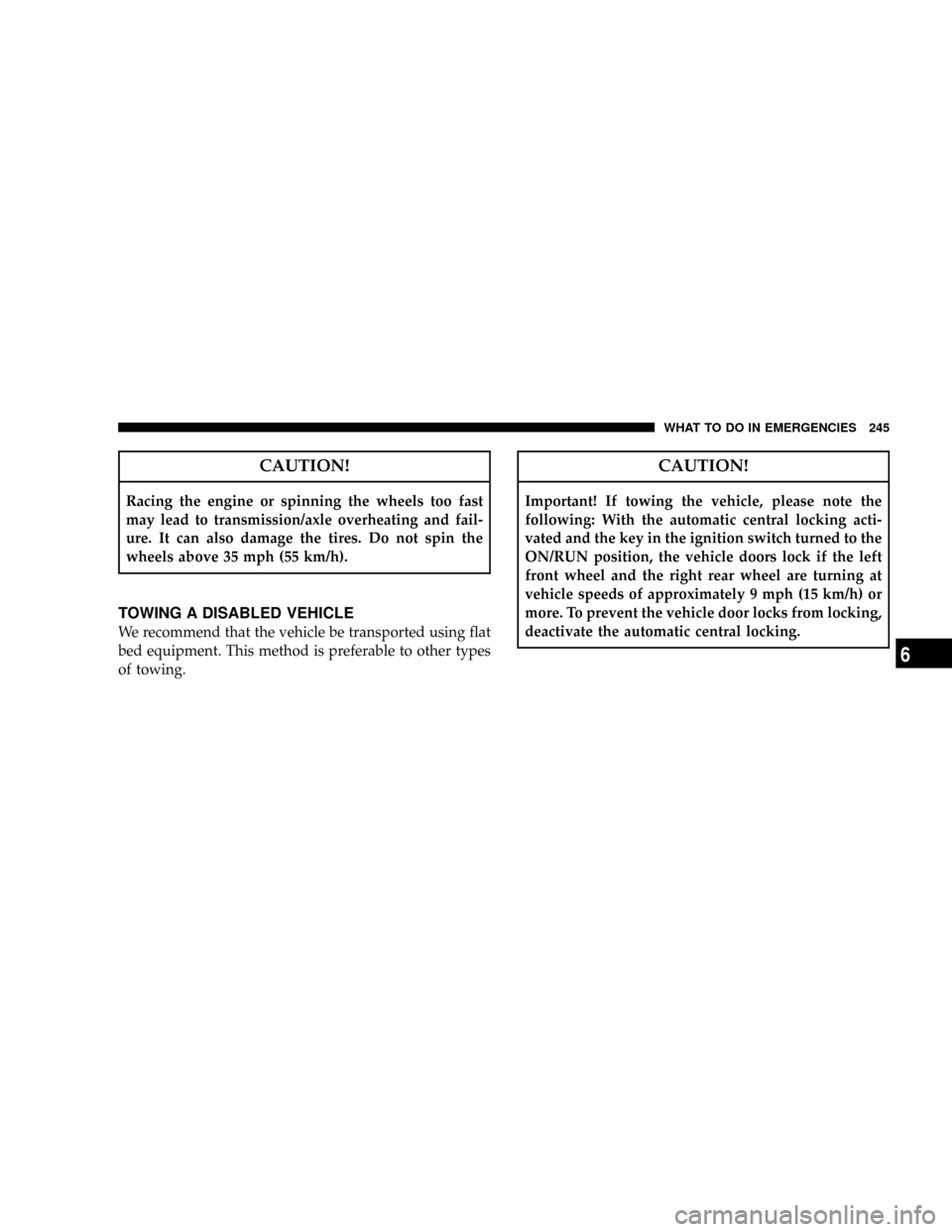
CAUTION!
Racing the engine or spinning the wheels too fast
may lead to transmission/axle overheating and fail-
ure. It can also damage the tires. Do not spin the
wheels above 35 mph (55 km/h).
TOWING A DISABLED VEHICLE
We recommend that the vehicle be transported using flat
bed equipment. This method is preferable to other types
of towing.
CAUTION!
Important! If towing the vehicle, please note the
following: With the automatic central locking acti-
vated and the key in the ignition switch turned to the
ON/RUN position, the vehicle doors lock if the left
front wheel and the right rear wheel are turning at
vehicle speeds of approximately 9 mph (15 km/h) or
more. To prevent the vehicle door locks from locking,
deactivate the automatic central locking.
WHAT TO DO IN EMERGENCIES 245
6
Page 248 of 358
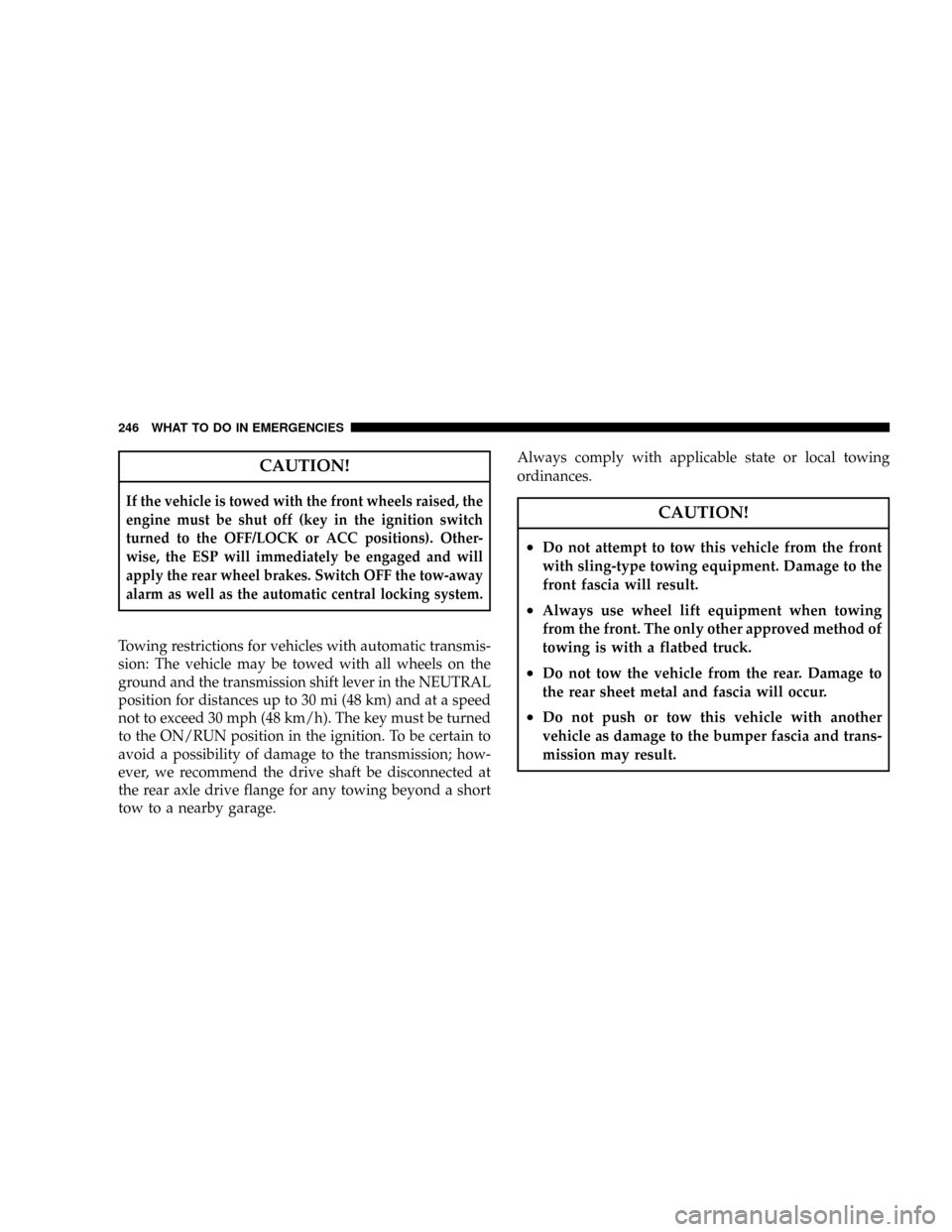
CAUTION!
If the vehicle is towed with the front wheels raised, the
engine must be shut off (key in the ignition switch
turned to the OFF/LOCK or ACC positions). Other-
wise, the ESP will immediately be engaged and will
apply the rear wheel brakes. Switch OFF the tow-away
alarm as well as the automatic central locking system.
Towing restrictions for vehicles with automatic transmis-
sion: The vehicle may be towed with all wheels on the
ground and the transmission shift lever in the NEUTRAL
position for distances up to 30 mi (48 km) and at a speed
not to exceed 30 mph (48 km/h). The key must be turned
to the ON/RUN position in the ignition. To be certain to
avoid a possibility of damage to the transmission; how-
ever, we recommend the drive shaft be disconnected at
the rear axle drive flange for any towing beyond a short
tow to a nearby garage.Always comply with applicable state or local towing
ordinances.
CAUTION!
²Do not attempt to tow this vehicle from the front
with sling-type towing equipment. Damage to the
front fascia will result.
²Always use wheel lift equipment when towing
from the front. The only other approved method of
towing is with a flatbed truck.
²Do not tow the vehicle from the rear. Damage to
the rear sheet metal and fascia will occur.
²Do not push or tow this vehicle with another
vehicle as damage to the bumper fascia and trans-
mission may result.
246 WHAT TO DO IN EMERGENCIES
Page 249 of 358
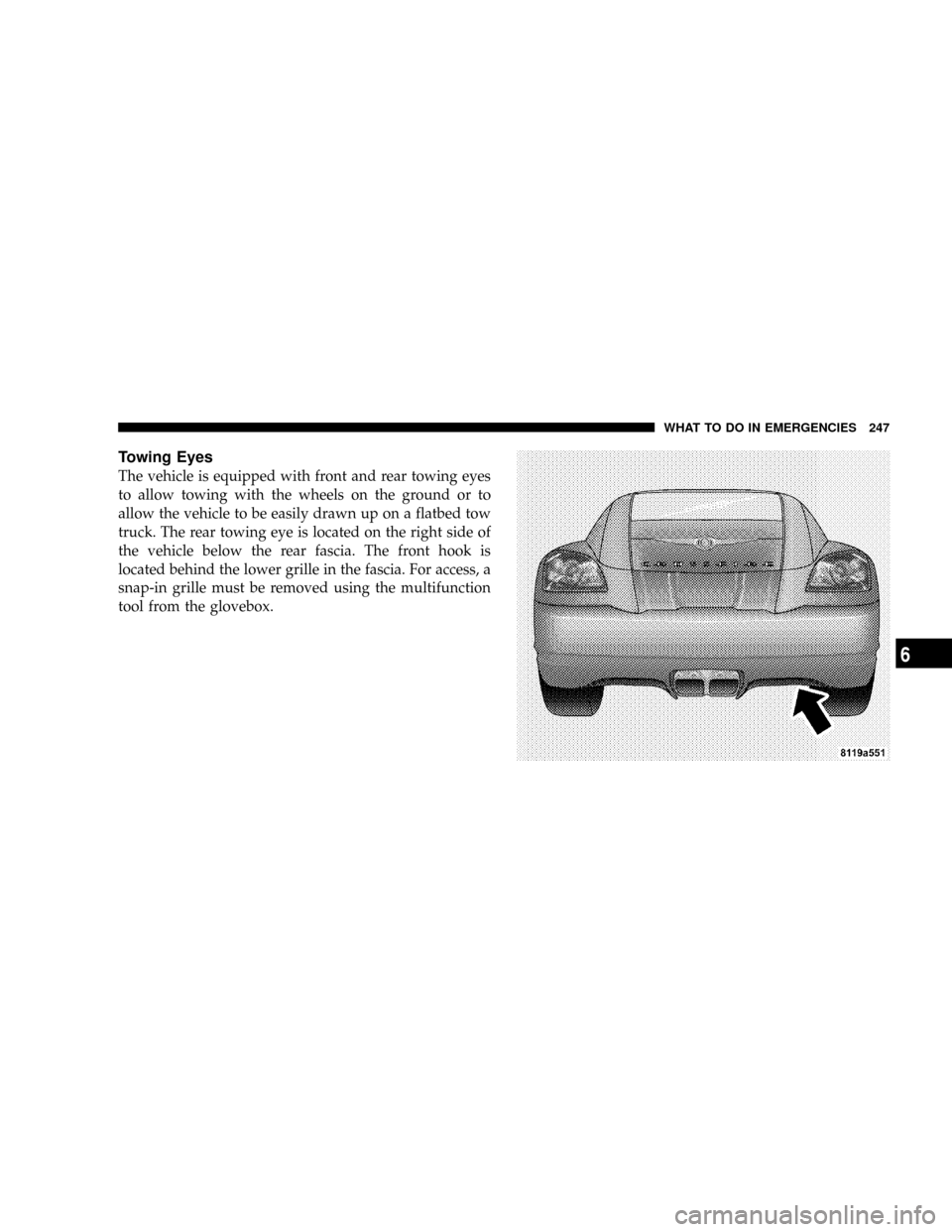
Towing Eyes
The vehicle is equipped with front and rear towing eyes
to allow towing with the wheels on the ground or to
allow the vehicle to be easily drawn up on a flatbed tow
truck. The rear towing eye is located on the right side of
the vehicle below the rear fascia. The front hook is
located behind the lower grille in the fascia. For access, a
snap-in grille must be removed using the multifunction
tool from the glovebox.
WHAT TO DO IN EMERGENCIES 247
6
Page 250 of 358

Insert the tool (or similar sized screwdriver) into the slot
in the grille as shown (the tool must be inserted far
enough to engage the clip on the left side of the grille).
Push the tool to the left to disengage the clip and detach
the grille. The front towing eye is now accessible.Tow-Away Alarm
Once the alarm system has been armed, the exterior
vehicle lights will flash and an alarm will sound when
anyone attempts to raise the vehicle for towing. The
alarm will last approximately three minutes in the form
of flashing exterior lights. At the same time, an alarm will
sound for 30 seconds. The alarm will stay on even if the
248 WHAT TO DO IN EMERGENCIES